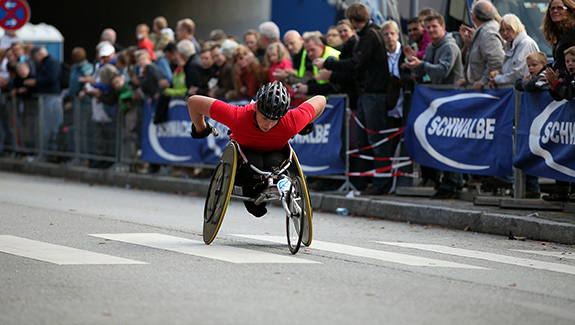Popular Wheelchair Sports
If you’re looking for competitive action, or just want to enjoy a group activity, there’s a wheelchair sport for you.

Get information on popular wheelchair sports.
Wheelchair sports offer the thrill of speed and mobility. You can take one up just for fun, or you can get in on some serious competition. Here is a brief overview of the most popular sports on wheels, including the equipment, rules, and resources you’ll need to get moving.
Wheelchair basketball
This very popular team competition is also the oldest wheelchair sport. It’s very physically demanding, and offers benefits like a sense of camaraderie, increases in strength and reflexes, and lots of fun!
Equipment: You can use a standard wheelchair, but most serious players use a basketball wheelchair. It has a lighter and smaller frame, slanted wheels for greater speed and agility, and no brakes.
Rules: Traditional basketball rules are modified. Each player receives points based on individual limitations. This functional classification system helps balance teams, so everyone is on a level playing field.
Get started: The International Wheelchair Basketball Federation is a great resource. In the U.S. The National Wheelchair Basketball Association organizes leagues and tournaments for players of all abilities.
“My number one sport is wheelchair basketball! I go twice a week to training — and what I learn there I can also use every day. I especially like this sport because it has to do with more than strength. One also needs a tactical understanding and team spirit in order to be successful.” — Alan R.
Wheelchair racing (“chairing”)
Fast wheelchair racing is becoming increasingly popular with track and field fans, as well as with endurance athletes. It also has a long history at the Paralympics. And almost every major marathon or running race has a wheelchair division.
Equipment: You don’t have to use a custom racing wheelchair, but more serious athletes do. These feature ultra-light frames and aerodynamic wheels. Gloves and a helmet are required.
Rules: Standard track regulations of 100 meters to 10,000 meters, and road race distances of half marathons and marathons are used. A classification system applies, based on severity of disability.
Get started: The Paralympic website is a great resource. You can also check local listings of races that might have a wheelchair division, or check with a local running, or track and field club.
Wheelchair handbikes
If wheelchair racing is akin to running, many people compare handcycling to bicycling. You drive your wheelchair forward using a hand crank, which really works your upper body. Try it for recreation, or sign up for a race.
Equipment: Adapter kits can convert your wheelchair. Or you can purchase an upright handbike designed for recreational use. A recumbent racing bike is the choice of competitors looking for serious speed. Custom racers feature ultra-light frames designed for your size and impairment.
Rules: Competitions have various categories organized by physical limitation, racing bike type, age group, and gender.
Get started: Check out the Paralympic website for more information.
“When handbiking, I am especially fascinated by the speed which one can achieve. In addition, I enjoy the ride in the fresh air. Because the bike is at home, I can start my ride when I like. This sport is particularly great to strengthen the upper body.” — Jeff T.
Wheelchair rugby
Some compare this sport to bumper cars. For those with tetraplegia and a competitive spirit, it’s a great action-packed sport. Wheelchair rugby is highly physical, and almost anything, other than direct physical contact with another player’s body, is allowed.
Equipment: The required rugby wheelchair is stable, built to take a few collisions, and designed to maneuver easily in this fast and exciting game.
Rules: The game is played with a volleyball on a basketball court. The goal is to rack up points by crossing the goal line with the ball and both wheels of the wheelchair.
Get started: The International Wheelchair Rugby Federation is the best place to explore this exciting sport.
“On the one hand, one can do everything that isn’t allowed on the highway... outbrake others and jostle people; on the other hand, a high degree of concentration is required. Because not the strongest, but the cleverest, wins.” — Jeff T.
Wheelchair tennis
Tennis offers social interaction, strength and cardio improvements, and many opportunities for recreational or competitive play. Most leagues and tournaments feature a wheelchair division in both singles and doubles formats.
Equipment: Serious players compete with a nimble sports wheelchair with wider wheels and a smaller frame. Standard tennis racquets and balls are used.
Rules: Two bounces are allowed before hitting the ball. Unlike other wheelchair sports, there is no classification system used.
Get started: Learn more at the International Tennis Federation. In the U.S., the United States Tennis Association has an excellent program as well.
Many other options
This is just a small sampling of some of the most popular wheelchair sports. Other options include: dancing, football, soccer, mountain biking, motocross, volleyball, swimming, and more. Plus, there are many non-wheelchair sports to choose from.
For more information on these and other wheelchair sports, visit the Wheelchair Sports Federation or Disabled Sports USA.


